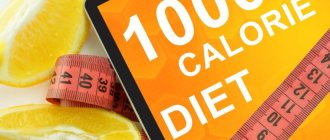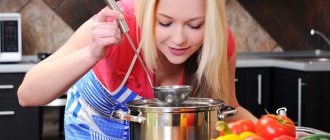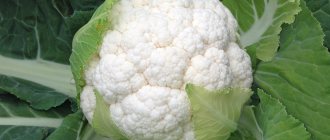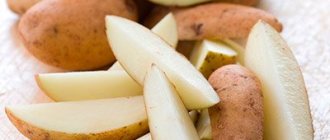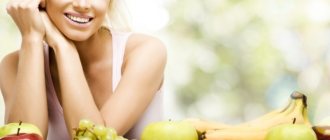This diet is suitable primarily for young mothers who have completed lactation (who constantly buy “baby” products), as well as for mega-busy women who do not have a minute to cook. A diet on baby food will not turn Melissa McCartney into Angelina Jolie - however, losing 2-4 extra pounds (fat, not muscle) will help.
Principles for creating a kindergarten menu
As mentioned above, the norms and principles by which the kindergarten menu is compiled are strictly regulated.
The daily diet for preschoolers should be varied and include meat, fish, milk and dairy products, eggs, butter, vegetables and fruits, bread and cereals.
Excluding one or more food groups from a child's diet leads to children having decreased concentration and energy, and they may get sick more often and complain of digestive problems. Products are combined in such a way that dishes are not repeated within 10-20 days - the nutrition of preschoolers should not only be correct, but also varied. After all, there is nothing more boring than eating semolina porridge for breakfast every day.
Preschool cooks are not Michelin stars, and you need to understand that dishes from the restaurant menu will not be available in the kindergarten. But there will be dishes tested over the years and generations of students: porridge, casseroles, steamed cutlets, soups. In addition, when serving, age characteristics are also taken into account - for children from the nursery group, the pieces and portions will be smaller, and possible allergens, such as oranges, will be excluded from the menu.
The grocery list for the kindergarten menu is compiled in such a way that one food group can easily replace another, without loss in calorie content. For example, chicken can be replaced with turkey, some vegetables with others, etc.
It is important to note that the diet of preschool children should not contain canned food, pickled foods, wild animal meat, dairy products with vegetable fats, carbonated drinks, fried and spicy foods.
First 1000 days concept
Nutrition in the first 1000 days of life (9 months of pregnancy + first 2 years) determines the child’s health throughout his life.
- Adequate nutrition of the mother during pregnancy ensures healthy growth of the baby, development of the brain and immune system.
- In addition, feeding on demand in the first 6 months is the prevention of dental problems in the baby: with proper latching of the nipple, the lower jaw moves forward and the entire jaw apparatus actively works, good blood supply and active lymphatic drainage of this area are ensured - the most important conditions for the formation of a correct bite and prevention caries.
- About 70% of a child’s brain is formed in utero, so it is important to avoid nutritional deficiencies (including healthy fats containing omega-3 acids), iodine, and iron, which are involved in the maturation of brain structures.
- With latent iron deficiency at an early age, as well as anemia, the risk of retarded physical and intellectual development of the child increases, which will be very difficult to correct at an older age. Because only during this period of 1000 days does the most rapid development of the brain and the formation of neural connections occur.
Calorie intake and age characteristics
The calorie content of meals in preschool educational institutions directly depends on age. Calorie calculation is carried out for two groups: children 1.5-3 years old, and children 4-6 years old.
If for the first age group the calorie content is 1550 kcal, then children of the older age group of preschool educational institutions should receive at least 1900 kcal per day. It is important to note that all meals in kindergarten should contain up to 30% fat, up to 15% protein and up to 55% carbohydrates in the total value of the diet. These standards were developed by the Institute of Nutrition of the Russian Academy of Medical Sciences.

Meals vary in their calorie content. Breakfast in kindergarten should account for 25% of a child's daily calorie needs, depending on his age group. Lunch and afternoon tea are 40 and 15% respectively. Therefore, if a child has dinner at home and not in kindergarten, parents should create a menu for this meal so that the child receives the remaining 20-25% of the calories he needs.
It is important to note that it is recommended to prepare dishes immediately before eating them. Food that has stood for more than two hours is considered unsuitable for children's kitchens.
According to current standards, the daily menu of a kindergarten should consist of 5 meals, and three meals should contain hot dishes, because without hot food healthy digestion and proper metabolism are impossible. Hot meals are provided to all children who spend more than 4 hours a day in a preschool institution (no matter municipal or private).
Also, according to pediatricians, a preschool child should eat every 4 hours. This important rule is also taken into account when creating menus in kindergartens. Below is the average meal schedule in preschool institutions:
- 8.30-9.00 - breakfast;
- 10.30-11.00 - second breakfast;
- 12.00-13.00 - lunch;
- 15.30-16.00 - afternoon snack;
- 17.00-17.30 - dinner.
Nutritious infant nutrition
Breast milk contains all the fats, proteins, microelements and vitamins a baby needs. And, importantly, they are fully absorbed by the child’s body. Formulas, no matter how balanced they are, are still less complete nutrition for children.

Here are the benefits of breast milk:
- Allergies to proteins contained in mother's milk practically never occur in children. In addition, they are rich in beneficial amino acids that are important for growth and development.
- Fats contain fatty acids, which are also very useful. In addition, they are better broken down thanks to lipase, which is found in breast milk. This guarantees the child normal stool, without constipation and painful colic.
- Among carbohydrates, breast milk contains lactose, which ensures normal acidity in the baby’s stomach and intestines. And this is of great importance for the life of bacteria (useful ones perform their functions, and harmful ones are suppressed). In addition, mother's milk contains enough calories for the baby's growth.
- The baby is protected from viruses and infections by immunity, the formation of which is facilitated by important hormones and biologically active components that make up breast milk.
- Breastfed children are less likely to be obese and have a lower risk of developing diabetes (in adulthood).
- Breast milk is the most complete nutrition for newborns; it is always at the right temperature, never stale, or sterile. There are no harmful bacteria in it, as there may be in artificial formulations.
- Babies who suckle at the breast develop a correct bite. In addition, it later reduces the risk of stomatitis or caries.
- Breastfeeding is also good because it forms a special emotional and psychological bond between mother and child. They are calm, the baby feels protected, the mother feels self-confident, which is important for the nervous system of both.
Legal norms and innovations
The director of the kindergarten can decide what products and dishes to feed the children, but provided that the new menu compiled meets the requirements, all documentation, and if the preschool children receive the calories necessary for their age. In addition, if desired, parents can familiarize themselves with the menu, which is compiled for at least 10 days. If questions or illegal situations arise, parents have the right to seek advice from the regional Rospotrebnadzor.
Supplies to the municipal kindergarten are carried out by the company that won the supply tender. However, each product that enters the kindergarten kitchen must have a quality certificate, all the necessary invoices and veterinary certificates.

At the moment (since January 2021), a number of changes in the organization of menus in kindergartens have come into force. There are more than 15 changes to SanPiN 2.3/2.4.3590-20, and one of the most important is that now the child can be fed food from home, and the preschool educational institution must provide a place where the food can be heated.
However, this does not mean that every preschooler can eat a burger instead of soup for lunch. This change was made mainly for children with allergies and is possible with the appropriate certificate.
Below you can see a sample weekly kindergarten menu.
Monday:
Breakfast: semolina porridge with marmalade, loaf with butter and cheese, tea with milk.
Second breakfast: peach juice.
Lunch: “Summer” salad (st. cucumber and tomato with green onions), pea soup, meatloaf with egg, pasta, cherry compote, wheat bread.
Afternoon snack: milk, waffles.
Dinner: vegetable stew, Royal salad (beets with lemon), tea with sugar, rye bread.
Tuesday:
Breakfast: “Solnyshko” corn porridge with milk, a loaf with butter, cocoa with milk.
Second breakfast: apple
Lunch: “Radish” salad of radishes and onions, pickle soup with sour cream, beef goulash, complex side dish (mashed potatoes, fried cabbage), dried apricot compote, wheat bread
Afternoon snack: bifilux (fermented milk drink), Viennese bun.
Dinner: noodle pie (casserole) with cheese, tea with lemon, rye bread.
Wednesday:
Breakfast: oatmeal porridge with milk, apple, loaf with butter and cheese, coffee drink with condensed milk.
Second breakfast: fruit.
Lunch: “Cabbage” salad (cabbage, onion), bean borscht served with sour cream, pink salmon baked with vegetables, rice, lingonberry jelly, rye bread.
Afternoon snack: tea with milk, marshmallows.
Dinner: omelet with sausage, fresh fruit compote, wheat bread.
Thursday:
Breakfast: wheat porridge, loaf with butter, cocoa with milk.
Second breakfast: juice.
Lunch: “Signor Tomato” salad, fish soup with herbs, liver beef stroganoff in sour cream sauce, buckwheat, currant compote, wheat bread.
Afternoon snack: cocoa drink, curl with jam.
Dinner: potato casserole with meat, “Cipolino” (onion) salad or “Princess and the Pea” salad (green peas), lingonberry drink, rye bread.
Friday:
Breakfast: milk noodle soup, loaf with butter and cheese, cocoa with milk.
Second breakfast: fruit.
Lunch: “Carrot” salad (boiled carrots with apple and onion), potato soup with meatballs and green peas, zucchini stuffed with meat, cranberry jelly, wheat bread.
Afternoon snack: tea with lemon, cookies.
Dinner: fish stew, Princess and the Pea salad (green peas, boiled egg), blueberry compote, rye bread.
- share with your friends!
Classification of the population by physical activity groups
The population is divided into physical activity groups, where group I consists of people with very low physical activity, mental workers; Group II – people engaged in light physical labor; Group III – medium-heavy manual workers; Group IV - workers of heavy physical labor, and this category also includes athletes, that is, according to modern terminology, people actively involved in fitness. Group V is intended only for men, it includes workers of very heavy physical labor and professional athletes during training.
Average basal metabolic rates
Rospotrebnadzor also establishes average basal metabolic rate (BMR) values. This is the minimum amount of energy required to carry out vital processes, that is, energy expenditure for the performance of all physiological, biochemical processes, for the functioning of the organs and systems of the body in a state of temperature comfort (20 degrees Celsius), complete physical and mental rest, on an empty stomach. These indicators take into account not only gender and age, but also weight.
The most accurate way to determine individual energy and macronutrient needs using Rospotrebnadzor data is by multiplying the BOO by a suitable physical activity coefficient.
